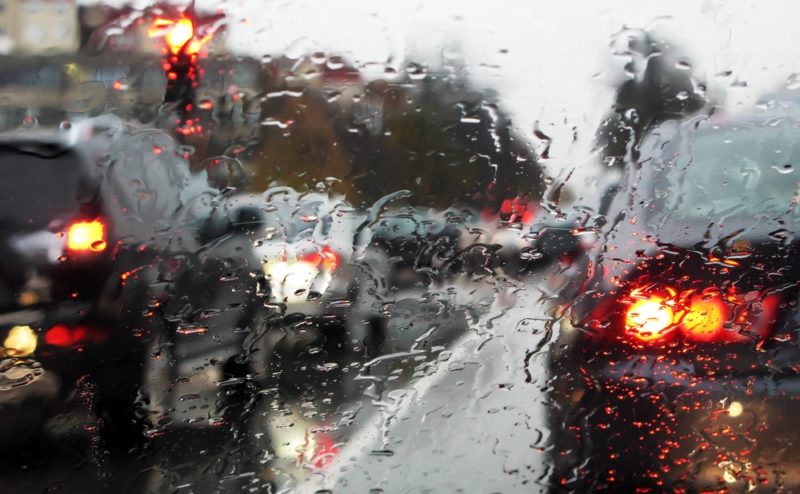Rain began falling in the Coachella Valley on Tuesday evening and that is just the start. Southern California is expected to receive light rain this week, according to the National Weather Service. Commuters can expect to wake up to the first rain of fall before Wednesday morning’s commute, and rain will continue through Thursday, according to forecasters.
The Automobile Club of Southern California urges Southland drivers to buckle up, slow down and allow more space between vehicles.
Flash flooding and debris flows are possible in the recent fire-burned areas, according to the weather service. Windshield wipers should be used while driving in the rain as well and, if possible, replaced before the rain, if needed.
“Wet roads significantly increase crash risk,” the Auto Club’s Community Programs & Traffic Safety Manager Anita Lorz Villagrana said in a news release. “Drivers should be alert, scan roadways, avoid road debris and watch for disabled vehicles in reduced visibility conditions. The Auto Club also reminds motorists to turn on their vehicle head lights, so they can see and be seen by other drivers,” she added. “California law requires drivers to turn on their headlights when windshield wipers are on during rain.”
To avoid crashes, the Auto Club recommends drivers:
- Slow down. Motorists should drive slowly, particularly through puddles that are expected with this weather system. Driving at slower speeds also helps drivers be prepared for sudden stops due to debris and other wet-weather driving hazards.
- Keep your distance/Avoid skids. A car needs two to three times more stopping distance on wet pavement, so allow extra following distance between cars. Sudden braking often leads to skids. Extra distance provides a buffer zone in case of skids. If the car skids and control is lost, do not slam on the brakes. Instead apply the brakes with a steady, light pressure. Remember to steer in the direction the car is sliding. When traction is regained, steering control will return. For cars equipped with anti-lock brakes, drivers should apply heavy steady pressure, but not pump the brakes.
- Use center lanes. When driving during heavy rain, use center lanes of the road (without straddling the yellow line). Avoid outside lanes where water collects at curbside.
- Avoid distractions. Motorists are advised to avoid eating, drinking, cellular phone use, texting, fumbling with items or applying makeup while driving, particularly in rain. If it’s necessary to engage in these activities, pull over and stop in a safe place.
- Stay informed. Tune into radio and television weather reports or use weather apps to know where traffic congestion or crashes might be located. If possible, avoid these areas.
- Watch for potholes. Leave plenty of space between your vehicle and the one in front of you. Alert drivers have plenty of time to avoid potholes. Before swerving around a pothole, be sure to check surrounding traffic to determine if it’s safe to change lanes.
- Maintain a safe speed. If a pothole cannot be avoided, slow down, if possible. Hitting a pothole at high speed increases the chance of damage to tires, wheels, shocks, struts, springs or suspension components. High speed also increases the chance of losing control of the vehicle, especially if a series of potholes occurs on a curved or uneven roadway. When driving over more than one pothole, reduce vehicle speed and hold the steering wheel firmly to avoid losing control.
- Don’t brake directly over a pothole. Applying brakes at this moment causes the car’s weight to shift to the front of the vehicle and can increase damage from the impact.
- Beware of pooled water on the road. It may be concealing a deep pothole. Hitting even one severe pothole could cause suspension damage and alter the alignment of a wheel resulting in uneven tire wear. Uneven and premature tire wear means the tire will need to be replaced sooner than necessary and increase fuel consumption.
Car maintenance needs increase during wet weather. Motorists are advised to follow this checklist:
- Check tires. Make sure tires are in good condition and are at recommended inflation. Driving with moderate tread or bald tires on a slippery surface is a major factor in skidding. In wet conditions, it’s advised that tires should have at least 6/32nd of an inch tread depth at any two adjacent grooves. Driving on tires that are over inflated or under inflated is also extremely dangerous on wet pavement.
- Check windshield wiper blades. Streaks or skipping on the windshield are signs of worn wiper blades. Inspect wipers monthly and check washer solvent reservoir to ensure it’s full. Use windshield washer fluid, not water, since it’s formulated to cut through oils that may get splashed on the windshield and won’t harm vehicle paint. Also, it may be helpful to use water repelling glass treatment on the outside of your windows and windshield.
- Check brakes periodically. After driving through puddles, check the brakes by tapping them gently a few times when it is safe to do so. Some newer vehicles’ brakes don’t need to be tapped.
- Use headlights and windshield defroster. Driving in rain means reduced visibility. The Auto Club recommends that motorists turn on the vehicle’s headlights. Also, turning on the defroster helps keep the inside of the windshield clear of moisture.
Image Sources
- Driving in the rain: Shutterstock





![Enrolling Now, Rewarding Careers Ahead [Sponsored]](https://ukenreport.com/wp-content/uploads/2024/04/COD_heroes_1-1385-2-440x264.jpg)

